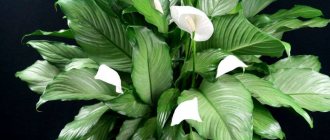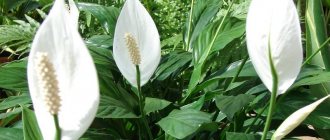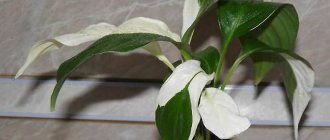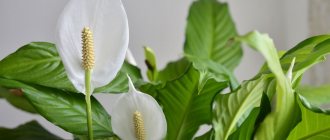Description and appearance
spathiphyllum flower - home care, the secret of success
Spathiphyllum domino is a hybrid obtained as a result of breeding work on the spathiphyllum plant. Belongs to the Araceae family. The peculiarity of the flower is that it has practically no stems; its lanceolate-oval green leaves with white streaks grow directly from the soil. Arrows with amazing flowers also appear from the ground. The stems can reach a height of 40 centimeters.
The flower blooms profusely
During the flowering period, the plant emits a very pleasant aroma. Due to the long flowering period, spathiphyllum is also called “women’s happiness.”
Spathiphyllum transplant
The pot should be changed when the roots become too crowded or the soil deteriorates. It is best to do this in the spring; during the flowering period such manipulations are undesirable.
Step-by-step instructions for transplantation:
- An hour before transplanting, water the spathiphyllum well.
- Carefully shake the flower out of the pot, being careful not to damage the root ball or leaves.
- Trim away dead root pieces.
- Make a drainage layer at the bottom of the new pot and pour wet soil and peat on top. Cover the roots, lightly compacting the soil. The soil should end at the level of the leaves.
Medicinal properties
Medinilla flower: home care and propagation methods
Spathiphyllum secretes biologically active substances that help a person relieve stress. It has phytoncidal properties and is able to purify the air from microbes and fungi hovering in it.
Note! Spathiphyllum is poisonous because its leaves contain calcium oxalate, which causes irritation of the mucous membranes and inflammation of the eyes. When cleaning, you should use gloves.
Description of the flower
This green comrade does not have medicinal properties. On the contrary, it is quite poisonous, so you should think twice about breeding it in a home where there are children and animals. But it has been scientifically proven that it perfectly purifies the air in the room, neutralizing harmful substances.
For your information! The flower's homeland is South America and Asia, and the variety itself was bred by breeders in Holland from the wild Spathiphyllum Wallis. To get beautiful variegated leaves, the plant was infected with a virus that causes such a mutation.
What does a flower look like
There are several other varieties that Domino is constantly confused with.
How to distinguish from other species
Spathiphyllum Domino has an uneven leaf color - green with white streaks. Spathiphyllum variety Gemini differs from the Domino variety - these two species have very different leaves. Spathiphyllum Gemini jemini has green leaves with light green streaks.
Green leaves of spathiphyllum Domino
The streaks are larger and located to the sides of the middle of the leaf in the form of a herringbone. The difference between Spathiphyllum Picasso picasso and Domino or gemini is that there are differences in the leaves. In Picasso they are painted more white. There are leaves on the bush with large white stripes and completely white ones.
Step-by-step care instructions
Selecting a location
Spathiphyllum Picasso loves good lighting. But the leaf plates should not be exposed to direct sunlight. Therefore, it is best to stir the pot on the south-eastern or eastern sides of the room. If you place the flowerpot on a southern windowsill, protect the plant from sunlight. To do this, hang sheets of paper on the window.
In autumn and winter, additional lighting is required (2-3 hours a day) - phytolamps are best suited for this.
What should the soil be like?
The soil for Spathiphyllum Picasso should be light, air- and water-permeable. The substrate must be regularly loosened, fertilized and moistened. The most optimal soil composition:
- peat;
- bark (preferably coniferous trees);
- sand (you need coarse sand, so it’s better to take river sand);
All this is taken in equal proportions.
Landing
The plant needs to be replanted in early spring, when its flowering has not yet begun. Landing instructions:
- Place a drainage layer on the bottom of the pot (its height is 1.5 -2 cm);
- up to half of the flowerpot is filled with the substrate described above;
- lay the plant, while the roots are spread with gentle movements over the entire surface of the soil, the shoots are pressed with light pressure;
- the remaining soil is sprinkled on top and compacted;
- water well and wait until the soil settles;
- add soil until the pot is full;
- leaf plates are sprayed;
- During the first five days, the seedling is stored under a cellophane cap.
Temperature
Spathiphyllum Picasso is a heat-loving plant. A drop in air temperature to 10 degrees or lower can lead to flower disease or death. The optimal temperature is 19-21 degrees above zero. In summer, if the air warms up more, spray the plant to cool the plant.
Watering
This type of plant loves moisture, so the soil in the flowerpot should be moistened all the time. Air humidity is also an important factor - it is kept at 40-50%.
You need to water twice a week, and pour plenty of water. Do not moisten the soil frequently and in small portions. In winter, the frequency of watering is reduced to once every seven days.
To further humidify the air, place a container of water next to the flower pot. As it evaporates, it raises the level of air humidity.
Spray the bush daily. Once a week, wipe the leaf blades with a damp cloth - this will protect the leaves from the accumulation of dust, which causes flower diseases.
Reference! For irrigation, it is better to use settled water (you can also use clean rainwater or filtered water).
Top dressing
In the spring and summer season, spathiphyllum Picasso needs intensive feeding. We recommend using complex fertilizers. It is better to purchase ready-made ones from a specialized store. Fertilizing is applied in small doses - 1-1.5 g per liter of water is enough. Fertilizers are introduced along with water so that beneficial elements reach the root system.
When the plant begins to bloom, stop feeding. For better flowering, Picasso is fertilized with potassium and phosphorus (taken in equal proportions).
You can use organic fertilizers - bird droppings. It is applied in small portions once a month.
Trimming
As soon as the buds have bloomed, the flower stalks are immediately removed - this is necessary so that the flower stalks do not take nutrients from the plant. Dry leaves should also be trimmed in a timely manner. Do not forget to remove the affected leaf blades and parts of the root.
After pruning, the cut sites are treated with crushed charcoal - this manipulation will protect the plant from infection.
Transfer
Transplantation is necessary for Spathiphyllum Picasso if the roots have grown greatly. This is done at the very beginning of spring before flowering begins.
Transplant algorithm:
- The old soil is moistened and allowed to soak for soaking.
- After this, the rhizomes are removed from the flowerpot and cleaned of old soil.
- The roots are inspected and, if rotten or dry, removed.
- A drainage layer 1.5-2 cm high is placed at the bottom of the pot.
- Sprinkle with earth (height 2-3 cm).
- Place the plant in a flowerpot and sprinkle with soil until it is completely filled.
- Water the flower a little so that the soil is compacted, then add more soil.
- In the first week after transplanting, cover the leaves with polyethylene. At the same time, remove it daily for ventilation.
Aerial roots do not need to be deeply buried - they will serve as additional support for the plant.
Home care
Care for spathiphyllum Domino at home requires compliance with certain rules.
Temperature
During the active growing season, the optimal temperature is –22-24 C °.
Luxurious spathiphyllum leaves
In winter, during the dormant period, – +16-17°C.
Lighting
The Domino variety needs a lot of diffused light; it needs to be shaded from active sunlight. Keeping the flower in the shade will worsen the quality of flowering and reduce the decorative properties of the leaves.
Watering
In the warm season, the flower is watered once every 2-3 days, in winter - once a week. For irrigation, use only purified and warm water.
Important! Abundant watering will provide the plant with real decorative beauty of leaves and flowering.
Spraying
In summer it is better to spray the plant every day, in winter – once every 3-4 days.
Humidity
Spathiphyllum Domino needs high air humidity - at least 40%.
Moistening a flower with a spray bottle
It is also worth wiping the leaves with a sponge and warm water.
Priming
Special soil mixtures are suitable for planting; they can be purchased at a flower shop. You can also prepare the soil yourself. The composition should include peat, leaf soil, humus, sand, crushed tree bark and charcoal. Everything is taken in equal parts.
Feeding
Fertilizing is carried out with complex liquid fertilizers. Fertilizing should be done during the active growing season and flowering period. To maintain the beauty of the leaves, nitrogenous fertilizers can be added to the soil once every two weeks.
Care during the rest period
Before the formation of buds, it is worth applying potassium-phosphorus fertilizer once every 14-20 days. After flowering, it is necessary to reduce the amount of watering and not apply fertilizers, since in winter the plant is in a dormant period.
Care during flowering
During flowering, it is important to remove all inflorescences that have faded; this will help preserve the decorative appearance of the bush and promote new release of buds.
Trimming
Pruning is carried out as necessary if there are limp or dry leaves, as well as after flowering has ended. Cut off all flower stalks that have already bloomed.
Transfer
The plant is transplanted into a new pot along with an old lump of earth. After transplantation, the flower is watered, fertilizing is applied only after 3 weeks.
Picture 8 Transplanting into a new pot
Bloom
When and how?
You can see the first flowers on the bush in May. This period lasts until September. At this time, the plant becomes even more decorative, as white flowers look impressive against the backdrop of variegated leaves. If you want to learn about other varieties with white flowers, we suggest reading this article.
Care before and after
Before the buds appear, apply fertilizer with a high concentration of phosphorus and potassium. Do this once every 2-3 weeks. During flowering, abundant and regular watering is important. It is important that the earthen lump does not dry out. During flowering, remove all faded inflorescences in a timely manner so as not to disturb the decorative appearance of the bush and stimulate it to produce new buds. After flowering, reduce watering and stop fertilizing, as the plant rests in winter.
What to do if this doesn't happen?
Spathiphyllum Domino generally does not bloom due to the presence of too much or insufficient light, nutritional components, or as a result of rotting of the roots. Rearranging the pot, trimming old leaves and changing the frequency of watering will help solve the problem.
If the care is correct and the plant does not bloom, then you can use the shock method. Its essence is to reduce hydration for 3 weeks, and then stop it completely for 8-10 days. After the specified time, fertilize and water as before.
Reproduction options
Spathiphyllum can be grown from seeds or propagated by rooting cuttings or dividing the bush.
Picture 7 Spathiphyllum Domino in a pot
Germination of seeds
The seeds of the plant are placed in a prepared substrate consisting of garden soil and river sand. The plantings are covered with film and left at a temperature of +18-20 degrees. When the first shoots appear, the temperature is lowered to +10-15 degrees. Water as the top layer of soil dries.
Rooting cuttings
Young stems are selected from the bush and cut at a right angle. All leaves are removed from the lower part, treated with a root growth stimulator and planted in the ground. During the rooting period, the plantings are covered with film. When the cuttings take root, you need to remove the cover and care for it like an adult plant.
Part of a bush
The bush is removed from the pot and divided into several parts. Next, all parts of the bush need to be transplanted into new pots and watered well. Apply fertilizer after 1 month.
Features of caring for spathiphyllum Picasso
Spathiphyllum Picasso loves sunlight very much.
Lighting. Unlike other varieties, Picasso tolerates bright light well. You just need to protect the leaves from sunburn.
Temperature. In summer, spathiphyllum Picasso will easily tolerate temperatures up to 30°C, but it will be more comfortable at 25-27°C. In winter, it is better to lower the temperature to 15-18°C.
Watering. Like a true resident of the tropics, spathiphyllum loves water. In nature, it grows in swamps and damp places, so it needs to be properly maintained indoors. In summer, watering should be more frequent; in winter, as the temperature drops, the soil should be moistened less frequently. It is necessary to water when the top layer of soil dries out. To prevent the roots from rotting if you try too hard, the water from the pan must be drained. Brown spots that appear indicate excessive waterlogging. Only distilled water should be used.
Humidity. Spathiphyllum will be grateful for spraying and bathing in the shower
During flowering, this procedure should be done carefully so that water does not get on the cob and cover.
Feeding. Alternating mineral and organic fertilizers, fertilizing should be done once a week in summer and once a month in winter. Timely feeding during flowering will give the plant the necessary strength.
The soil should contain leaf soil, peat and sand. Some gardeners add broken bricks. Very good drainage is necessary.
Spathiphyllum transplantation is required every year.
An important feature: spathiphyllum will never bloom in a pot that is too large, since, having received space for roots to grow, it will not have the strength to bloom. After transplanting, watering is temporarily stopped. To maintain the required humidity, the plant is sprayed 2 times a day. As soon as the flower recovers from stress, the previous care is resumed.
Possible problems during cultivation
Although Domino spathiphyllum is unpretentious in care, the following troubles can occur with it.
Drops buds and leaves
Spathiphyllum gets sick from a draft and drops its leaves. You need to take care of the plant and not place it on windows that are opened for ventilation in winter.
The leaves are turning pale
If there is a lack of complex mineral fertilizers, the flowers on the plant will become smaller, the leaves will turn pale and growth will slow down.
The tips of the leaves are drying out
The reason is dry air. You need to constantly spray and use a humidifier. Yellowing of leaves can also occur when watering with hard water or due to insufficient moisture in the soil.
No flowering
The reason is not enough light, watering or fertilizer. You also need to promptly remove faded inflorescences.
The lower leaves fall off
The reason is the presence of insect pests. It is necessary to treat the bush with tobacco crumbs.
Pests
Most often the flower is affected by:
- Spider mites - use insecticides;
- Scale – treat with tobacco crumbs;
- Aphids - use chemicals;
- Mealybug - treat leaves with alcohol.
Diseases and pests
Problems such as drying, yellowing leaves, and the appearance of spots on them can be the result of both improper care and infectious diseases.
- Leaves can dry out due to low air humidity, as well as due to the development of root rot (at the same time they still turn black). Large spots may appear due to excess fertilizer.
- Blackening of the leaves around the edges and curling indicates a bacterial infection of gommosa. Infected leaves must be removed immediately.
- Yellowing of the leaf and the appearance of green veins indicates chlorosis, which occurs due to a lack of iron in the soil.
- The appearance of brown spots on the leaves may indicate late blight, a fungal infection from which the plant cannot be cured.
Among the pests that pose a danger to spathiphyllum are spider mites and mealybugs.
Fighting methods
It is necessary to take timely measures when a particular problem arises: analyze and correct errors in care - sometimes this is enough for the plant to recover.
The main preventative measure is proper care:
- sufficient, but not excessive watering;
- proper lighting and humidity;
- a thorough examination of the leaves to detect the disease at an early stage.
We must not forget that a plant is a living organism
Spathiphyllum Picasso will certainly reward you for your attention and care with its unique charm, pleasing the eye for many years
Signs and superstitions
It is believed that if spathiphyllum enters the house, then women will find happiness: unmarried women will get married, married women will find harmony in their relationships.
Spathiphyllum Domino in a pot
Additional Information. The flower will help you find understanding with your partner, and will also eliminate all quarrels between residents of the house of different age categories.
When caring for spathiphyllum, you need to adhere to all the rules of growing, then it will delight you with snow-white flowers and an amazing aroma for a long time.
Choosing a place in the room
The plant prefers bright light, but it is better to avoid direct sunlight, as it causes leaf burns. Therefore, if the rays fall on the flower, it is better to cover it. In other seasons, a window sill on the southeast side is perfect. In winter, dormancy begins, and the plant does not require additional lighting.
The recommended air temperature is no higher than 17 °C; in summer the flower feels great at 22–25 °C. If the spathiphyllum Domino (the photo colorfully conveys the attractiveness of the flower) is watered abundantly, then it will withstand the heat. You need to decide in advance on its location. Spathiphyllum Domino, like all other varieties, does not tolerate frequent rearrangements and does not like drafts.
How to propagate?
Cuttings
It should be carried out in spring or summer. Procedure:
- Cut off the leaf rosette and place in water. You can use raw sand. Wait until roots form.
- If they are already formed, then direct planting into the ground can be carried out.
Dividing the bush
It is better to divide the spathiphyllum bush in the spring. The separated part of the plant should have 3 strong leaf rosettes and part of a healthy rhizome.
Deepen the cuttings to the same depth as in the previous pot. Before dividing, soak the roots with water, wash them and untangle them. Then clean and powder the sections with crushed charcoal.
Seeds
Procedure:
- Plant the planting material in a container with moist soil, which consists of sand and peat. Cover the seedlings with polyethylene.
- Maintain soil moisture by spraying.
- Open the film every day until seedlings form.
- Plant them in separate containers when 2-3 leaves are formed.
Spalyphyllum spoon-shaped
Another interesting variety of spathiphyllum was discovered in Brazil. This is Spathiphyllum Cochlearispathum - a plant that grows up to a meter in height and has thin, shiny, elliptical leaves. With a width of 12–15 cm, the length of one rich green leaf reaches 30–40 cm. Moreover, the petioles are also very long and can grow up to 70 cm.
The species received its name due to the white spathe that maintains its concave shape, which becomes densely green as the cob matures.
Care: watering the plant and fertilizing
In summer and spring, spathiphyllum Domino is regularly watered with warm, settled water. Caring for the plant also includes spraying the leaves, as well as wiping dust from them.
Caring for a flower involves constant feeding with mineral complexes, which are sold in specialized stores. It is recommended to feed the plant from April to September, when active growth occurs. The best frequency is approximately once every fourteen days.
Similarities and differences with Anthurium
Sometimes amateur flower growers try to find in the store Women's happiness with a red leaf - a blanket, confusing Spathiphyllum with Anthurium, another representative of the Araceae family. But all types of Spathiphyllum are characterized by white petals, sometimes with cream or greenish shades of veins and inclusions. After flowering they most often turn bright green. But they can only be made red using chemical paint. The photo below shows the differences between Spathiphyllum and Anthurium.
Anthurium in many characteristics and in appearance is really similar to Spathiphyllum. It is its funnel-shaped petals that wrap the cob that lead to confusion, as they come in red, pink, purple and other colors and shades. Anthurium, unlike “Women’s Happiness,” symbolizes the masculinity and strength of men.
You can learn more about Male happiness in the article Types and varieties of indoor Anthurium.
Popular varieties and their photos
To date, botanists know more than 40 varieties of “female happiness.” And only a few of them are used in the field of landscaping and home germination.
Spathiphyllum Wallis
It was named after the discoverer G. Wallis. This species is the most common variety. It is most suitable for growing in apartment conditions, as it is characterized by small dimensions.
The size is 20-35 cm in height. It has a white cob, a narrow oblong veil, which is three times longer than the cob. Spathiphyllum Wallis is unpretentious in care.
profusely blooming
The ancestor of this species is considered to be wild spathiphyllum, which grows in tropical forests, and hybrid descendants are commercially available. It grows up to half a meter in height, that is, medium size.
The leaves are green, oval-shaped, up to 20 cm long. The spathe reaches 12cm, and the peduncle is 25cm. It stands out among others for its abundant year-round flowering.
Charming
This species is much larger than the previous one. The difference lies in the shape and structure of the leaf. The lovely spathiphyllum has an elliptical leaf with visually noticeable veins.
The length of the leaf plate is about 30cm. The stalk connecting the root to the leaf is the same length. In nature, this species can be found in Suriname.
Spoon-shaped
A tall flower, reaching 1 meter in height. The leaf shape is oval, its width is 15 cm. The color of the leaf blade is bright green with a glossy sheen. The petiole grows upward by 50-70cm. Found in tropical forests of Brazil.
Anyone who likes white varieties of spathiphyllum will be interested in reading about such varieties as Alana and Domino, the extraordinary Sweet, the mysterious Chopin, the gentle Sensation, the lovely Cupido, the miniature Strauss and the beautiful Picasso.











